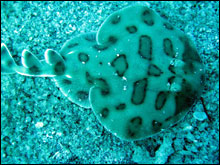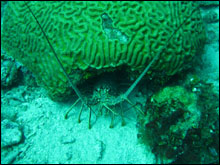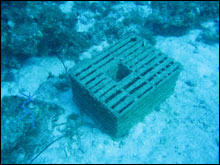Error processing SSI file
|
Mission Blog: Sept. 26, 2009
Chelsea Lowes, Onboard Cruise Log Coordinator
Knauss Sea Grant Fellow, NOAA Ecosystem Research Program
 |
| The lesser electric ray diet includes worms, snake eels, and small crustaceans. (Photo: NOAA CCFHR) |
Now that our 30 permanent sites have been completed, we have switched into exploration mode. Brian Degan worked late into the night pouring over multibeam data to designate sites for today's dives. We started out with a very aggressive dive schedule of 17 sites and ended the day with 14 sites completed using the same diver-based methodology. Everything ran extremely smoothly - camera downloads, batteries recharged, tanks filled - and the crew was so helpful and flexible. None of this would be possible without them.
We have been seeing some more unusual organisms too! Jenny Vander Pluym spotted a lesser electric ray on the sandy bottom.
 |
| A spiny lobster peers out from under coral head. (Photo: NOAA CCFHR) |
We have also been seeing quite a few long-spined sea urchins and spiny lobsters. These can surprise you as you peer under ledges or into sheltered spots where they like to hide during the day!
Unfortunately, we have also been coming across marine debris at some sites. NOAA defines marine debris as "any persistent solid material that is manufactured or processed and directly or indirectly, intentionally or unintentionally, disposed of or abandoned into the marine environment or the Great Lakes." Some of the marine debris that we have seen includes lines and derelict lobster traps.
 |
| This derelict lobster trap has lost the surface float used to show its location for retrieval. (Photo: NOAA CCFHR) |
These can be especially detrimental when they are still intact because lobsters crawl in, are unable to escape, and the traps cannot be located and retrieved by the fishermen. Derelict nets have the potential to entangle sea life such as sea turtles and dolphins and can be damaging to benthic habitat such as on coral, sponges, and seagrass. These sightings make us glad to have NOAA's Marine Debris program working to decrease this threat to our oceans' health. Visit their website to learn more about marine debris and what you can do in your everyday life to help prevent it.
|



